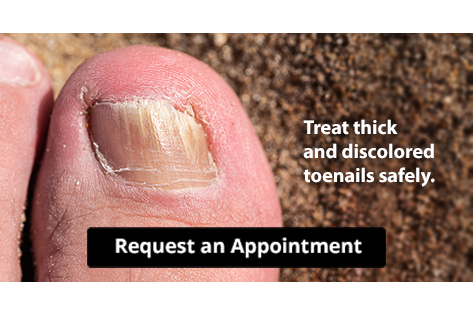Connect With Us
Blog
Items filtered by date: October 2024
Overpronation and Risk of Injuries
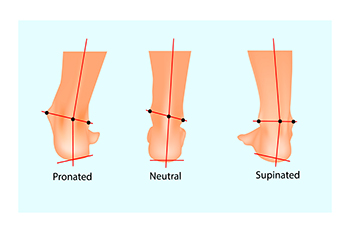
Overpronation occurs when the arches of the feet roll inward excessively while walking or running. This condition, also known as flat feet or pes planus, can lead to improper alignment and increased pressure on the lower body. People with overpronation may experience pain in the feet, ankles, knees, or hips, especially during high-impact activities. Common causes of overpronation include a naturally flexible arch, obesity, injury, or certain medical conditions that affect the foot's structure. Left untreated, overpronation can increase the risk of stress fractures, shin splints, and tendonitis. A podiatrist can evaluate your gait and recommend a variety of treatments. Included are custom orthotics, choosing more supportive footwear, or recommending specific exercises to strengthen the foot muscles and improve alignment. These solutions can help reduce discomfort and prevent further injury. If you have problems with overpronation, it is suggested that you schedule an appointment with a podiatrist for an exam and diagnosis.
If you have any concerns about your feet, contact Richard M. Allen, DPM from Idaho. our doctor can provide the care you need to keep you pain-free and on your feet.
Biomechanics in Podiatry
Podiatric biomechanics is a particular sector of specialty podiatry with licensed practitioners who are trained to diagnose and treat conditions affecting the foot, ankle and lower leg. Biomechanics deals with the forces that act against the body, causing an interference with the biological structures. It focuses on the movement of the ankle, the foot and the forces that interact with them.
A History of Biomechanics
- Biomechanics dates back to the BC era in Egypt where evidence of professional foot care has been recorded.
- In 1974, biomechanics gained a higher profile from the studies of Merton Root, who claimed that by changing or controlling the forces between the ankle and the foot, corrections or conditions could be implemented to gain strength and coordination in the area.
Modern technological improvements are based on past theories and therapeutic processes that provide a better understanding of podiatric concepts for biomechanics. Computers can provide accurate information about the forces and patterns of the feet and lower legs.
Understanding biomechanics of the feet can help improve and eliminate pain, stopping further stress to the foot.
If you have any questions please feel free to contact our office located in Lewiston, ID . We offer the newest diagnostic and treatment technologies for all your foot and ankle needs.
Causes of Big Toe Pain
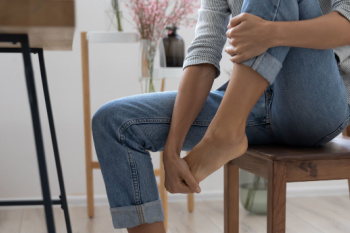
Big toe pain can result from biomechanical problems or arthritis in the metatarsophalangeal, or MTP joint, where the base of the toe meets the foot. Biomechanical issues arise when there is an imbalance in the way the bones, tendons, and muscles function together, causing pressure to shift to the front of the foot. This action can lead to bunions, where the big toe pushes against the second toe, and turf toe, caused by overextending the toe during high-impact activities. Arthritis-related pain is the result of joint inflammation from gout, osteoarthritis, or rheumatoid arthritis. Symptoms often include swelling, stiffness, and difficulty walking. A podiatrist can help by diagnosing the underlying cause of the big toe pain. Treatments like custom orthotics, specific exercises, or in some cases, surgery may be suggested. If you are experiencing pain in the big toe, it is suggested that you schedule an appointment with a podiatrist for an exam and treatment.
Toe pain can disrupt your daily activities. If you have any concerns, contact Richard M. Allen, DPM of Idaho. our doctor can provide the care you need to keep you pain-free and on your feet.
What Causes Toe Pain?
Most severe toe pain is caused due to a sports injury, trauma from dropping something heavy on the toe, or bumping into something rigid. Other problems can develop over time for various reasons.
Toe pain can be caused by one or more ailments. The most common include:
- Trauma
- Sports injury
- Wearing shoes that are too tight
- Arthritis
- Gout
- Corns and calluses
- Hammertoe
- Bunions
- Blisters
- Ingrown toenails
- Sprains
- Fractures (broken bones)
- Dislocations
When to See a Podiatrist
- Severe pain
- Persistent pain that lasts more than a week
- Signs of infection
- Continued swelling
- Pain that prevents walking
Diagnosis
In many cases the cause of toe pain is obvious, but in others, a podiatrist may want to use more advanced methods to determine the problem. These can range from simple visual inspections and sensation tests to X-rays and MRI scans. Prior medical history, family medical history, and any recent physical traumatic events will all be taken into consideration for a proper diagnosis.
Treatment
Treatments for toe pain and injuries vary and may include shoe inserts, padding, taping, medicines, injections, and in some cases, surgery. If you believe that you have broken a toe, please see a podiatrist as soon as possible.
If you have any questions please feel free to contact our office located in Lewiston, ID . We offer the newest diagnostic tools and technology to treat your foot and ankle needs.
Types and Symptoms of Plantar Warts
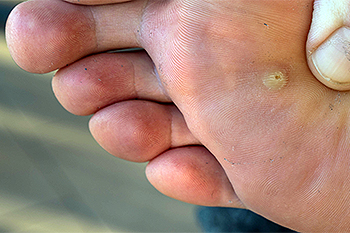
Plantar warts are benign growths that develop on the soles of the feet due to an infection with the human papillomavirus, or HPV. These warts can appear as small, rough lesions and are often mistaken for calluses. There are various types of plantar warts, including common warts, which are usually painless, and mosaic warts, which cluster together in groups. Symptoms include discomfort or pain while walking, especially when pressure is applied to the wart. The warts may also have tiny black dots in the center, which are small blood vessels. Plantar warts are primarily caused by direct contact with the virus, often found in moist environments like swimming pools and locker rooms. Plantar warts can be painful and may cause difficulty in completing daily activities. If you have developed this condition, it is strongly suggested that you promptly contact a podiatrist who can offer you the correct treatment method.
Plantar warts can be very uncomfortable. If you need your feet checked, contact Richard M. Allen, DPM from Idaho. our doctor will assist you with all of your foot and ankle needs.
About Plantar Warts
Plantar warts are the result of HPV, or human papillomavirus, getting into open wounds on the feet. They are mostly found on the heels or balls of the feet.
While plantar warts are generally harmless, those experiencing excessive pain or those suffering from diabetes or a compromised immune system require immediate medical care. Plantar warts are easily diagnosed, usually through scraping off a bit of rough skin or by getting a biopsy.
Symptoms
- Lesions on the bottom of your feet, usually rough and grainy
- Hard or thick callused spots
- Wart seeds, which are small clotted blood vessels that look like little black spots
- Pain, discomfort, or tenderness of your feet when walking or standing
Treatment
- Freezing
- Electric tool removal
- Laser Treatment
- Topical Creams (prescription only)
- Over-the-counter medications
To help prevent developing plantar warts, avoid walking barefoot over abrasive surfaces that can cause cuts or wounds for HPV to get into. Avoiding direct contact with other warts, as well as not picking or rubbing existing warts, can help prevent the further spread of plantar warts. However, if you think you have developed plantar warts, speak to your podiatrist. He or she can diagnose the warts on your feet and recommend the appropriate treatment options.
If you have any questions please feel free to contact our office located in Lewiston, ID . We offer the newest diagnostic and treatment technologies for all your foot and ankle needs.
Stop Your Toenail Fungus
Debridement of Diabetic Foot Wounds
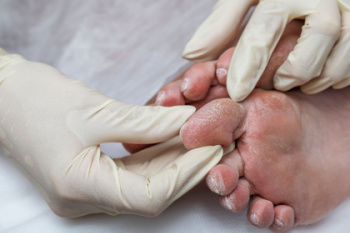
Debridement of diabetic wounds is a critical procedure in wound care management, particularly for patients with diabetic foot ulcers. Diabetic wounds often heal slowly due to poor circulation and high blood sugar levels, leading to the buildup of dead or infected tissue that can hinder the healing process. Debridement involves the removal of this dead tissue, allowing healthy tissue to grow and promoting faster healing. This procedure reduces the risk of infection by eliminating bacterial growth in the wound, which can otherwise lead to more severe complications, including amputation. Debridement also improves the effectiveness of other treatments, such as dressings and medications, by creating a cleaner environment for wound healing. If you have diabetic foot wounds, it is strongly suggested that you visit a podiatrist to see if regular debridement sessions, in addition to proper diabetes management, can help prevent serious complications related to your condition.
Wound care is an important part in dealing with diabetes. If you have diabetes and a foot wound or would like more information about wound care for diabetics, consult with Richard M. Allen, DPM from Idaho. our doctor will assess your condition and provide you with quality foot and ankle treatment.
What Is Wound Care?
Wound care is the practice of taking proper care of a wound. This can range from the smallest to the largest of wounds. While everyone can benefit from proper wound care, it is much more important for diabetics. Diabetics often suffer from poor blood circulation which causes wounds to heal much slower than they would in a non-diabetic.
What Is the Importance of Wound Care?
While it may not seem apparent with small ulcers on the foot, for diabetics, any size ulcer can become infected. Diabetics often also suffer from neuropathy, or nerve loss. This means they might not even feel when they have an ulcer on their foot. If the wound becomes severely infected, amputation may be necessary. Therefore, it is of the upmost importance to properly care for any and all foot wounds.
How to Care for Wounds
The best way to care for foot wounds is to prevent them. For diabetics, this means daily inspections of the feet for any signs of abnormalities or ulcers. It is also recommended to see a podiatrist several times a year for a foot inspection. If you do have an ulcer, run the wound under water to clear dirt from the wound; then apply antibiotic ointment to the wound and cover with a bandage. Bandages should be changed daily and keeping pressure off the wound is smart. It is advised to see a podiatrist, who can keep an eye on it.
If you have any questions, please feel free to contact our office located in Lewiston, ID . We offer the newest diagnostic and treatment technologies for all your foot care needs.
Preventing Injuries Before and After Your Run
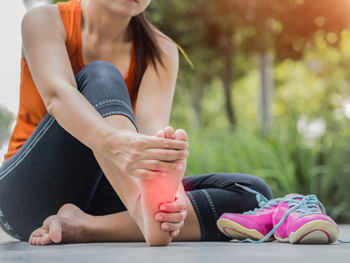
Incorporating stretches into your running routine is vital for injury prevention and overall performance. Before running, dynamic stretches such as leg swings and high knees help warm up the muscles and improve flexibility, preparing your body for the activity ahead. Additionally, lunges with a twist can enhance hip mobility and balance. After running, static stretches like hamstring stretches and calf stretches are essential for cooling down and reducing muscle stiffness. Holding each stretch for about 30 seconds helps release tension and aids in recovery. Regularly performing these stretches before and after your runs can reduce the risk of injuries, improve flexibility, and support overall running efficiency. If you have sustained a foot injury from running, it is suggested that you visit a podiatrist who can offer you relief and treatment options, and guide you on the importance of stretching before and after running.
Exercising your feet regularly with the proper foot wear is a great way to prevent injuries. If you have any concerns about your feet, contact Richard M. Allen, DPM of Idaho. our doctor will treat your foot and ankle needs.
How to Prevent Running Injuries
Many common running injuries are caused by overuse and overtraining. When the back of the kneecap starts wearing out and starts causing pain in your knee, this is commonly referred to as runner’s knee. Runner’s knee is a decrease in strength in your quadriceps and can occur if you’re not wearing properly fitted or supporting shoes. To prevent runner’s knee, focusing on hip strengthening is a good idea, as well as strengthening your quads to keep the kneecaps aligned.
What Are Some Causes of Running Injuries?
- One cause of a common running injury is called iliotibial band syndrome.
- Plantar fasciitis is also another common injury.
- Stress fractures can occur from overtraining, lack of calcium, or even your running style.
Best Ways to Prevent Running Injuries
- Wear footwear that fits properly and suits your running needs.
- Running shoes are the only protective gear that runners have to safeguard them from injury.
- Make a training schedule. Adding strengthening exercises as well as regular stretching can help keep you strong and limber and can lessen the possibility of injuries.
- Stretching keeps muscles limber; this will help you gain better flexibility.
If you have any questions please feel free to contact our office located in Lewiston, ID . We offer the newest diagnostic and treatment technologies for all your foot and ankle needs.
